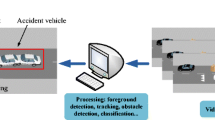Abstract
This paper proposes a novel dynamic obstacle recognition system combining global feature with local feature to identify vehicles, pedestrians and unknown backgrounds for a driver assistance system. The proposed system consists of two main procedures: a dynamic obstacle detection model to localize an area containing a moving obstacle, and an obstacle identification model, which is a hybrid of global and local information, for recognizing an obstacle with and without occlusion. A dynamic saliency map is used for localizing an area containing a moving obstacle. For the global feature analysis, we propose a modified GIST using orientation features with MAX pooling, which is robust to translation and size variations of an object. Although the global features are a compact way to represent an object and provide a good accuracy for non-occluded objects, they are sensitive to image translation and occlusion. Thus, a local feature-based identification model is also proposed and combined with the global feature. As such, for the obstacle identification problem, the proposed system mainly follows the global feature-based object identification. If the global feature-based model identifies a candidate area as background, the system verifies the area again using the local feature-based model. As a result, the proposed system is able to provide information on both the appearance of obstacles and the class of an obstacle. Experimental results show that the proposed model can successfully detect obstacle candidates and robustly identify obstacles with and without occlusion.










Similar content being viewed by others
Explore related subjects
Discover the latest articles, news and stories from top researchers in related subjects.References
Fleming B (2008) Automotive safety and convenience electronics. J IEEE Veh Tech 3:10–40
Kuehnle A (2002) Symmetry-based recognition for vehicle rears. Patt Recog Lett 90(7):1258–1271
Buluswar S, Draper B (1998) Color machine vision for autonomous vehicles. Int J Eng Appl Artif Intell 1(2):245–256
Dickmanns E et al (1994) The seeing passenger car ‘vamors-p’. Proc Int Symp Int Veh 24–26
Goerick C, Detlev N, Wemer M (1996) Artificial neural networks in real-time car detection and tracking applications. J Patt Recog Lett 17:335–343
Kalinke T, Tzomakas C, Seelen W (1998) A texture-based object detection and an adaptive model-based classification. Proc IEEE Int Conf Intell Veh 143–148
Lisin D, Matter M, Blaschko M (2008) Combining local and global image features for object class recognition. CVPR
Turk M, Pentland A (1991) Eigenfaces for recognition. J Cogn Neurosci 3:71–86
Oliva A (2005) Gist of the scene. J Neurobiol Atten CA 251–256
Viola P, Jones M (2001) Rapid object detection using a boosted cascade of simple features. Proc Compt Vis Pattern Recog 511–518
Leibe B, Leonardis A, Schiele B (2004) Combined object categorization and segmentation with an implicit shape model. Proc Euro Conf Compt Vis Prague
Riesenhuber M, Poggio T (1999) Hierarchical models of object recognition in cortex. J Neurosci 2:1019–1025
Ban S, Lee I, Lee M (2008) Dynamic visual selective attention. J Neurocompt 71(4–6):853–856
Woo J, Lim Y, Lee M (2009) Obstacle categorization based on hybridizing global and local features. LNCS 5864:1–10
Kadir T, Brady M (2001) Scale, saliency and image description. Int J Compt Vis 45(2):83–105
Choi S, Jung B, Ban S, Niitsuma H, Lee M (2006) Biologically motivated vergence control system using human-like selective attention model. J Neurocompt 69(4–6):537–558
Treisman A, Gelde G (1980) A feature-integration theory of attention. J Cog Psychol 12(1):97–136
Itti L, Koch C, Niebur E (1998) A model of saliency-based visual attention for rapid scene analysis. J IEEE Trans Patt Anal Mach Intell 20(11):1254–1259
Park S, An K, Lee M (2002) Saliency map model with adaptive masking based on independent component analysis. J Neurocompt 49(1):417–422
Jeong S, Ban S, Lee M (2008) Stereo saliency map considering affective factors and selective motion analysis in a dynamic environment. J Neural Netw 21(10):1420–1430
Huber D, Wiesel T (1968) Receptive fields and functional architecture of monkey striate cortex. J Physiol 148:574–591
Fukushima K (2005) Use of non-uniform spatial blur for image comparison: symmetry axis extraction. J Neural Netw 18:23–32
Burges C (1998) A tutorial on support vector machines for pattern recognition. J Data Min Knowl Discov 2:121–167
Harris C, Stephens M (1988) A combined corner and edge detector. Proc 4th Alvey Vision Conf 147–151
Rodgers J, Nicewander W (1988) Thirteen ways to look at the correlation coefficient. Am J Stat 42(1):59–66
Computational Vision Lab., Caltech., http://www.vision.caltech.edu
Center for Biological & Computational Learning, MIT, http://cbcl.mit.edu
Acknowledgments
This research was supported by the Daegu Gyeongbuk Institute of Science and Technology (DGIST) and the IT R&D program of MKE/KETI. [10033776, Core technology development of large-scale, intelligent and cooperative surveillance system]. Also, this research was supported by the Converging Research Center Program through the National Research Foundation of Korea (NRF) funded by the Ministry of Education, Science and Technology (2009-0082262)(50%).
Author information
Authors and Affiliations
Corresponding author
Rights and permissions
About this article
Cite this article
Woo, JW., Lim, YC. & Lee, M. Dynamic obstacle identification based on global and local features for a driver assistance system. Neural Comput & Applic 20, 925–933 (2011). https://doi.org/10.1007/s00521-010-0401-9
Received:
Accepted:
Published:
Issue Date:
DOI: https://doi.org/10.1007/s00521-010-0401-9




